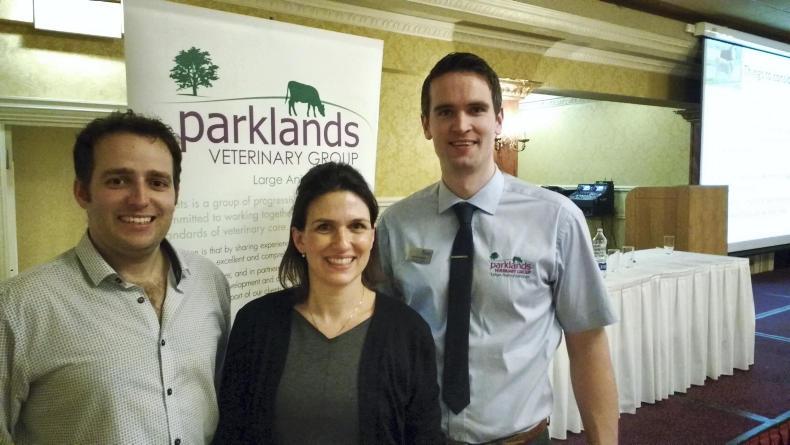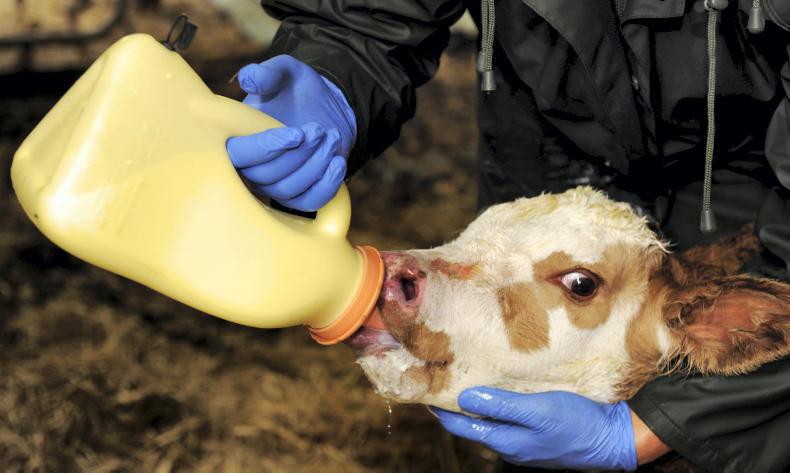There was a wide range of management and veterinary issues discussed at a meeting attended by nearly 200 suckler producers organised by Parklands Veterinary Group in Cookstown last week.
However, with peak calving season fast approaching, perhaps the most important issue highlighted was the management of newborn calves this spring.
Getting colostrum into calves is vital as it will give the animal immunity against a wide range of diseases early in life. The best practice advice is that a calf should get two litres by two hours and four litres of colostrum by six hours (or three litres of high-quality colostrum). “By 12 hours, a calf only has 10% capacity to absorb colostrum, so get it in as quickly as possible,” said David McKinstry from Parklands.
It can take a newborn calf up to 20 minutes to suckle one litre, although that will also depend on the milking ability of the cow. There is also a range in colostrum quality across breeds, with high-yielding dairy cows having lower immunoglobulin (antibody) concentration than specialist suckler breeds. A Holstein Friesian calf requires a minimum of four litres in the first six hours – half of dairy calves left to suckle will not receive enough colostrum to provide adequate immunity.
That fact should be noted by any suckler producer who relies on a local dairy farmer for a supply of colostrum in an emergency – the quality might be lower, especially if it is not from the first milking. There is also the risk of bringing Johne’s disease on to the farm in infected milk.
The ideal scenario is therefore to give the calf milk from the mother, or to use frozen colostrum taken from another cow in the herd. The other option is colostrum concentrate sold in a number of local agri-supply outlets. It is more expensive, but perhaps a better option than relying on a neighbouring dairy farmer.
Frozen
Colostrum can be kept in the fridge for up to a week and frozen for up to a year without significant decomposition. Thawing should be done slowly using warm (not hot) water, under 50oC. Too much heat will damage the colostrum antibodies. “We recommend farmers to use flat freezer bags rather than the two-litre milk jars as they are much easier to thaw,” suggested David McKinstry.
Where farmers are unsure about the techniques currently being used, ask your vet to conduct a blood test of a calf from two to five days old to check serum total protein levels. Serum protein rises as immunoglobulins are absorbed from colostrum. A low reading suggests management has not been adequate.
During the calving process a cow will naturally produce a lot of fluid and loose faeces. However, it is important to ensure that the calving pen is kept as clean and dry as possible. “It should be dry, with no draughts, but well ventilated. Spreading lime in the pen will also help to keep bugs down,” advised David McKinstry.
When cleaning pens out, if they are washed down, it is best to wait until the floor is dry again before bringing in new animals. If that is not possible, then clean out and apply some lime.
As the calving season progresses, the challenge from bugs in the environment increase, bringing a greater threat of calf scour. E coli scour usually affects a calf in the first week of life, while rotavirus and coronavirus normally affect the calf from five to 15 days. Cryptosporidium usually affects calves over one week old.
Rotavac corona vaccination administered between three weeks and three months pre-calving covers calves against rotavirus, coronavirus and E coli K99. To ensure it works effectively, a calf must receive colostrum from the cow within six hours of life.
If there are problems with scour on the farm, a useful starting point is to take a dung sample from a sick calf to your local vet. “Cryptosporidium is now the most common cause of calf scour. Treatment with antibiotics doesn’t work well, so you will probably need to administer Halocur or Obionekk,” suggested McKinstry.
In slightly older calves from three weeks up to six months, they can pick up coccidiosis from the environment, particularly in over-stocked sheds or contaminated surface water in fields or dirty areas around water troughs. In severe cases, diarrhoea contains mucus and flecks of fresh blood. Treatment is with the likes of Baycox or Vecoxan.
While having well-ventilated housing is key to minimising the risks posed by pneumonia, mild, damp weather at housing time can still lead to problems.
A survey in 2014 across Parklands clients showed that RSV and PI3 are the most prevalent viruses involved in an outbreak (90% of farms). IBR was found on 32% of farms, and BVD on 28%.
Use of an effective vaccine will help to control problems linked to these viruses. However, increasing in prevalence has been Mycoplasma bovis, found on 55% of farms in 2014, but nearly 70% of farms in 2016.
Mycoplasma bovis is difficult to treat, and often suspected when cattle with pneumonia to not respond to drugs.

Speakers at the Parklands meeting in Cookstown were (from left), David McKinstry (Parklands), Aurelie Moralis (Zoetis) and Patrick Grant (Parklands).
Pre-calving
As well as vaccinations administered to cows to reduce the risk of scour, other vaccinations that can be administered pre-calving include those against salmonella.
Abortion associated with salmonellosis usually occurs in cows infected with Salmonella Dublin. Vaccination involves a primary course of two doses, three weeks apart, followed by a booster administered three to four weeks pre-calving. “If you are having issues with abortion, or working with pedigree animals, it is something you should use,” suggested Patrick Grant from Parklands.
He also maintained that all herds should be vaccinating against BVD and leptospirosis prior to mating. “These vaccines are not expensive. Get it done four to six weeks before you put the bull out,” he said.
Buy a bull in advance of breeding
A mature fertile bull should be capable of serving 40 to 50 cows during the breeding season and achieve pregnancy rates to each service of at least 60%. However, a sub-fertile bull is likely to have a pregnancy rate of 40%, leading to extended calving intervals, and more cows not-in-calf at the end of breeding.
“In total, 20% of bulls are in this category and the causes are issues such as poor libido, a hurt, poor semen quality or disease. If you have any concerns get the bull checked at least one month before he goes to the cows,” advised David McKinstry.
When buying a young bull, he maintained that the animal should be bought now, to give it a chance to get acclimatised to a new environment. “Too many young bulls are overfed, and just not ready to go to cows,” he said.
Keeping disease out of the herd
There are a number of wildlife species that act as a reservoir of potential disease for cattle herds.
Rabbits are a potential source of infection for Johne’s disease, rats and mice are a potential reservoir for leptospirosis and cattle may become infected with neospora (increases risk of abortion in cows) by the ingestion of oocysts shed by infected dogs.
“It is important to understand the potential ways in which disease can spread, and minimise contact. Keep rodents under control, keep dogs away from cattle feed and water and dispose of cleanings and aborted or dead calves,” advised Patrick Grant from Parklands.
With much attention also currently on bovine TB, Grant emphasised the importance of minimising contact between badgers and cattle. He said that farmers should identify badger setts and latrines (where badgers deposit their droppings) and fence these areas off. “You put a fence around bales in the corner of a field, so why not put a fence around a badger sett?” he asked.
To reduce the risk of badgers coming into the yard at night, he said it was important to clear up any feed around a meal bin and close up feed stores.
He also suggested that farmers could do more to keep badgers from entering their yards, either by fixing some chicken wire to gates, using a nine-bar gate, or attaching rubber to the bottom of doors.






 This is a subscriber-only article
This is a subscriber-only article












SHARING OPTIONS: